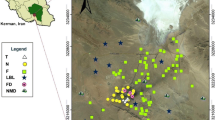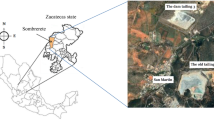Abstract
The study was conducted to characterize mineralogical and elemental composition of mine tailings in order to evaluate the environmental hazards, and identify the metal accumulation potential of native plant species from São Domingos mine, one of the long-term activity mines of the Iberian Pyrite Belt dating back to pre-Roman times. The mine tailings including soils and different plant species from São Domingos were analyzed for determination of tailings characteristics and chemical element contents in tailings and plants. The large amounts of mining wastes are causing significant adverse environment impacts due to acid mine drainage production and mobilization of potentially toxic metals and metalloids in residential areas, agricultural fields, downstreams, and rivers. The typical mineralogical composition is as follows: quartz, micas, K-feldspar, olivine-group minerals, magnetite, goethite, hematite, jarosite, and sulfides. The mine tailings were highly contaminated by As, Ag, Cr, Hg, Sn, Sb, Fe, and Zn; and among them, As and Sb, main contaminants, attained the highest concentrations except Fe. Arsenic has exhibited very good correlations with Au, Fe, Sb, Se, and W; and Sb with As, Au, Fe, Se, Sn, and W in tailings. Among the all plant species, the higher concentrations of all the metals were noted in Erica andevalensis, Erica australis, Echium plantagium, and Lavandula luisierra. Considering the tolerant behavior and abundant growth, the plant species Erica australis, Erica andevalensis, Lavandula luisierra, Daphne gnidium, Rumex induratus, Ulex eriocladus, Juncus, and Genista hirsutus are of major importance for the rehabilitation and recovery of degraded São Domingos mining area.

Similar content being viewed by others
References
Abreu, M. M., Tavares, M. T., & Batista, M. J. (2008). Potential use of Erica andevalensis and Erica australis in phytoremediation of sulfide mine environments: São Domingos, Portugal. Journal of Geochemical Exploration, 96, 210–222.
Alvarez-Valero, A. M., Perez-Lopez, R., Matos, J., Capitan, M. A., Nieto, J. M., Saez, R., et al. (2008). Potential environmental impact at Sa˜o Domingos mining district (Iberian Pyrite Belt, SW Iberian Peninsula): evidence from a chemical and mineralogical characterization. Environmental Geology, 55, 1797–1809.
Anawar, M. H., Garcia-Sanchez, A., Murciego, A., & Buyolo, T. (2006). Exposure and bioavailability of arsenic in contaminated soils from the La Parrilla mine, Spain. Environmental Geology, 50, 170–179.
Aparício, A., & García-Martin, F. (1996). The reproductive biology and breeding system o Erica andevalensis Cabezudo and Rivera (Ericaceae), an endangered edaphic endemic of southwestern Spain. Implications for its conservation. Flora, 191, 345–351.
Buján, E., Saiz, J. L., Ceacero, C. J., & Macias, F. (2006). Relaciones sueloplanta en comunidades de E. andevalensis en suelo de mina de la Faja Pirítica Andaluza. Resúmenes, II Congresso Iberico de la Ciencia del Suelo (p. 1). Spain: Huelva.
CCME––Canada Council of Ministers of the Environment. (1997). Canadian Environmental Quality Guidelines for the protection of environmental and human health, Winnipeg.
Custódio, J. (1996). Sistemas de lavra na Mina de S. Domingos. In: Câmara Municipal de Castro Verde (Ed.), Mineração no Baixo Alentejo. Castro Verde, Portugal, 174–185.
Garcia, B. M. (2006). Análisis del estrés oxidativo en Ericáceas de la comarca de El Andévalo (Huelva). PhD Thesis. Universidad de Huelva, Spain.
Garcia, B. M., Hidalgo, P. J., Dominguez, D. M., Heras, M. A., & Garcia, F. C. (2005). Por qué Erica andevalensis sobrevive en condiciones extremas de contaminación ambiental? Abstracts of the 6th Iberian and 3rd Iberoamerican Congress of Environmental Contamination and Toxicology (p. 260). Spain: Cadiz.
Gaspar, O. C. (1998). História da mineração dos depósitos de sulfuretos maciços vulcanogénicos da Faixa Piritosa Portuguesa. Boletim de Minas 35/4, 401–414. [Lisboa].
Hooper, D. U., & Vitousek, P. M. (1997). The effects of plant composition and diversity on ecosystem processes. Science, 277, 1302–1305.
Hooper, D. U., & Vitousek, P. M. (1998). Effect of plant composition and diversity on nutrient cycling. Ecological Monograph, 68, 121–149.
Jianguang, Z., Yufang, L., Junyi, Z., Suping, G., Baoguo, L., & Wenjiang, W. (2007). Threshold criteria for heavy metals in the soils of hazard-free dry fruit production regions of China. Front. Agriculture China, 1, 193–196.
Kabata-Pendias, A., & Pendias, H. (1992). Trace elements in soils and plants (2nd ed.). Boca Raton, FL: CRC Press.
Kabata-Pendias, A., & Pendias, H. (2001). Trace elements in soils and plants (3rd ed.). Boca Raton, FL: CRC Press.
Khan, A. G., Kuck, C., Chaudhry, T. M., Khoo, C. S., & Hayes, W. J. (2000). Role of plants, mycorrhizae and phytochelators in heavy metal contaminated land remediation. Chemosphere, 21, 197–207.
Lothenbach, B., Krebs, R., Furrer, G., Gupta, S. K., & Schulin, R. (1998). Immobilization of cadmium and zinc in soil by Al-montmorillonite and gravel sludge. European Journal of Soil Science, 49, 141–148.
Mehra, A., Farago, M. E., & Banerjee, D. K. (1998). Impact of fly ash from coal fired stations in Delhi, with particular reference to metal contamination. Environmental Monitoring and Assessment, 50, 15–35.
Prasad, M. N. V., & Freitas, H. (1999). Feasible biotechnological and bioremediation strategies for serpentine soils and mine spoils. Electronic Journal of Biotechnology, 2, 36–50.
Rai, U. N., Pandey, K., Sinha, S., Singh, S., Saxena, R., & Gupta, D. K. (2004). Revegetating fly Ash landfills with Prosopis juliflora L: Impact of different amendments and Rhizobium inoculation. Environment International, 30, 293–300.
Raskin, I., & Ensley, B. D. (Eds.). (2000). Phytoremediation of toxic metals using plants to clean the environment. New York: John Wiley & Sons.
Saez, R., Pascual, E., Toscano, M., & Almodovar, G. R. (1999). The Iberian type of volcano-sedimentary massive sulfide deposits. Mineralium Deposita, 34, 549–570.
Soldevilla, M., Maranón, T., & Cabrera, F. (1992). Heavy metal content in soil and plants from a pyrite mining area in south-west Spain. Communications in Soil Science and Plant Analysis, 23, 1301–1319.
Srivastava, P. C., & Gupta, U. C. (1996). Trace elements in crop production (p. 356). USA: Science Publishers, Inc.
Tripathi, R. D., Vajpayee, P., Singh, N., Rai, U. N., Kumar, A., Ali, M. B., et al. (2004). Efficacy of various amendments for amelioration of fly-ash toxicity: Growth performance and metal composition of Cassia siamea Lamk. Chemosphere, 54, 1581–1588.
Wong, M. H. (2003). Ecological restoration of mine degraded soils, with emphasis on metal contaminated soils. Chemosphere, 50, 775–780.
Zhang, Z. Q., Shu, W. S., Lan, C. Y., & Wong, M. H. (2001). Soil seed bank as an input of seed source in revegetation of lead/zinc mine tailings. Restoration Ecology, 9, 1–8.
Acknowledgments
The authors are grateful to the anonymous reviewers whose critical comments have improved the manuscript. Prof. Dr. Iain Thornton and Dr. Chaosheng Zhang are especially thanked for their editorial handling. This research work was supported by the Fundação para Ciência e Tecnologia (FCT, Portugal) through research contract PTDC/AMB/65462/2006––HYPERAS. The principal author (H.M.A) thanks FCT for his post-doctoral grant.
Author information
Authors and Affiliations
Corresponding author
Rights and permissions
About this article
Cite this article
Anawar, H.M., Freitas, M.C., Canha, N. et al. Arsenic, antimony, and other trace element contamination in a mine tailings affected area and uptake by tolerant plant species. Environ Geochem Health 33, 353–362 (2011). https://doi.org/10.1007/s10653-011-9378-2
Received:
Accepted:
Published:
Issue Date:
DOI: https://doi.org/10.1007/s10653-011-9378-2




